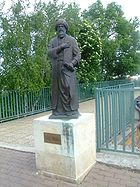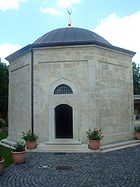.gif)
Gül Baba (poet)
Encyclopedia

Ottoman Empire
The Ottoman EmpireIt was usually referred to as the "Ottoman Empire", the "Turkish Empire", the "Ottoman Caliphate" or more commonly "Turkey" by its contemporaries...
Bektashi
Bektashi
Bektashi Order or Bektashism is an Islamic Sufi order founded in the 13th century by the Persian saint Haji Bektash Veli. In addition to the spiritual teachings of Haji Bektash Veli the order was significantly influenced during its formative period by both the Hurufis as well as the...
dervish
Dervish
A Dervish or Darvesh is someone treading a Sufi Muslim ascetic path or "Tariqah", known for their extreme poverty and austerity, similar to mendicant friars in Christianity or Hindu/Buddhist/Jain sadhus.-Etymology:The Persian word darvīsh is of ancient origin and descends from a Proto-Iranian...
poet and companion of Sultan
Ottoman Dynasty
The Ottoman Dynasty ruled the Ottoman Empire from 1299 to 1922, beginning with Osman I , though the dynasty was not proclaimed until Orhan Bey declared himself sultan...
Suleiman the Magnificent
Suleiman the Magnificent
Suleiman I was the tenth and longest-reigning Sultan of the Ottoman Empire, from 1520 to his death in 1566. He is known in the West as Suleiman the Magnificent and in the East, as "The Lawgiver" , for his complete reconstruction of the Ottoman legal system...
who took part in a number of campaigns in Europe
Ottoman wars in Europe
The wars of the Ottoman Empire in Europe are also sometimes referred to as the Ottoman Wars or as Turkish Wars, particularly in older, European texts.- Rise :...
from the reign of Mehmed II
Mehmed II
Mehmed II , was Sultan of the Ottoman Empire for a short time from 1444 to September 1446, and later from...
onwards.
A native of Merzifon
Merzifon
Merzifon is a town and district in Amasya Province in the central Black Sea region of Turkey. It covers an area of 970 km², and the population is 69,237 of which 52,947 live in the town of Merzifon, the remainder spread throughout the surrounding countryside...
(Marsiwān, in the vilāyet
Wilayah
A wilāyah or vilâyet , or vilayat in Urdu and Turkish, is an administrative division, usually translated as "province", rarely as "governorate". The word comes from the Arabic "w-l-y", "to govern": a wāli — "governor" — governs a wilayah, "that which is governed"...
of Sivas
Sivas, Turkey
Sivas is a city in east-central Turkey and the seat of Sivas Province. According to the 2007 Turkish census, its population was 300,795.The city, which lies at an elevation of in the broad valley of the Kızılırmak river, is a moderately-sized trade center and industrial city, although the economy...
), he was the son of Kutb’ül Arifin Veli’üddin İbn Yalınkılıç. In Hungary
Hungary
Hungary , officially the Republic of Hungary , is a landlocked country in Central Europe. It is situated in the Carpathian Basin and is bordered by Slovakia to the north, Ukraine and Romania to the east, Serbia and Croatia to the south, Slovenia to the southwest and Austria to the west. The...
, Gül Baba is known as the "Father of Rose
Rose
A rose is a woody perennial of the genus Rosa, within the family Rosaceae. There are over 100 species. They form a group of erect shrubs, and climbing or trailing plants, with stems that are often armed with sharp prickles. Flowers are large and showy, in colours ranging from white through yellows...
s," indeed, that is what his names means in Turkish, and is said to have introduced the flower to the country. However, this is likely a misunderstanding of the metaphorical use of the term which referred to the dervish's status derived from his deep mystical knowledge of Allah
Allah
Allah is a word for God used in the context of Islam. In Arabic, the word means simply "God". It is used primarily by Muslims and Bahá'ís, and often, albeit not exclusively, used by Arabic-speaking Eastern Catholic Christians, Maltese Roman Catholics, Eastern Orthodox Christians, Mizrahi Jews and...
. Roses, wild and domesticated, were already in Hungary by the time of the Ottoman invasion. The name could also be a corruption of Kel Baba, meaning "Bald Father".

Buda
For detailed information see: History of Buda CastleBuda is the western part of the Hungarian capital Budapest on the west bank of the Danube. The name Buda takes its name from the name of Bleda the Hun ruler, whose name is also Buda in Hungarian.Buda comprises about one-third of Budapest's...
during the first Muslim
Islam
Islam . The most common are and . : Arabic pronunciation varies regionally. The first vowel ranges from ~~. The second vowel ranges from ~~~...
religious ceremony held after the Ottoman victory of 1541, or alternatively to have been killed during fighting below the walls of the city on August 21, 1541. Suleiman, who was also Caliph
Ottoman Caliphate
The Ottoman Caliphate, under the Ottoman Dynasty of the Ottoman Empire inherited the responsibility of the Caliphate from the Mamluks of Egypt....
, declared him patron saint
Patron saint
A patron saint is a saint who is regarded as the intercessor and advocate in heaven of a nation, place, craft, activity, class, clan, family, or person...
of the city and is reputed to have been one of the coffin bearers. Gül Baba's descendants are the Marzioglu family, some of whom were the pashas of the Trebizond Vilayet.
Gül Baba's octagonal tomb (türbe
Turbe
Türbe is the Turkish word for "tomb", and for the characteristic mausoleums, often relatively small, of Ottoman royalty and notables. It is related to the Arabic turba, which can also mean a mausoleum, but more often a funerary complex, or a plot in a cemetery.-Characteristics:A typical türbe...
) is located on Mecset (mosque) Street, Budapest
Budapest
Budapest is the capital of Hungary. As the largest city of Hungary, it is the country's principal political, cultural, commercial, industrial, and transportation centre. In 2011, Budapest had 1,733,685 inhabitants, down from its 1989 peak of 2,113,645 due to suburbanization. The Budapest Commuter...
, a short but steep walk from the Margaret Bridge
Margaret Bridge
Margit híd or Margaret Bridge is a bridge in Budapest, Hungary, connecting Buda and Pest across the Danube. It is the second northernmost and second oldest public bridge in Budapest....
in the district of Rózsadomb
Rózsadomb
The area known as Rózsadomb is a wealthy area of the Buda side of Budapest, the capital of Hungary.Rózsadomb is part of the 2nd district in Budapest, in the Buda Hills, one of the most prestigious areas in Hungary. Most of the city's wealthiest and most famous residents live here . House prices...
. It was built by Ottoman authorities in Hungary
Ottoman Hungary
History of Ottoman Hungary refers to the history of parts of the Ottoman Empire situated in what today is Hungary, in the period from 1541 to 1699.-History:...
between 1543 and 1548, on the orders of the third pasha
Pasha
Pasha or pascha, formerly bashaw, was a high rank in the Ottoman Empire political system, typically granted to governors, generals and dignitaries. As an honorary title, Pasha, in one of its various ranks, is equivalent to the British title of Lord, and was also one of the highest titles in...
of Buda, and has a shallow dome covered with lead plates and wooden tiles. It was left undamaged when the Habsburg
Habsburg Monarchy
The Habsburg Monarchy covered the territories ruled by the junior Austrian branch of the House of Habsburg , and then by the successor House of Habsburg-Lorraine , between 1526 and 1867/1918. The Imperial capital was Vienna, except from 1583 to 1611, when it was moved to Prague...
armies captured the area during the Second Battle of Buda
Battle of Buda (1686)
The Battle of Buda was fought between the Holy League and Ottoman Turkey, as part of the follow-up campaign in Hungary after the Battle of Vienna...
in 1686, but was converted into a Roman Catholic
Roman Catholicism in Hungary
The Roman Catholic Church in Hungary is part of the worldwide Roman Catholic Church, under the spiritual leadership of the Pope and curia in Rome....
chapel
Chapel
A chapel is a building used by Christians as a place of fellowship and worship. It may be part of a larger structure or complex, such as a church, college, hospital, palace, prison or funeral home, located on board a military or commercial ship, or it may be an entirely free-standing building,...
by the Jesuits, who renamed it "St. Joseph's Chapel".
The land later came under the ownership of János Wagner, who maintained the site and allowed access to Muslim pilgrim
Pilgrim
A pilgrim is a traveler who is on a journey to a holy place. Typically, this is a physical journeying to some place of special significance to the adherent of a particular religious belief system...
s coming from the Ottoman Empire (see Islam in Hungary
Islam in Hungary
Islam in Hungary has a long history that dates back to at least the twelfth century, predating the Ottoman Empire. The influence of Muslims was especially pronounced in the 16th century during the time of Ottoman Hungary....
). In 1885, the Ottoman government commissioned a Hungarian engineer to restore the tomb and, when work was completed in 1914, it was declared a national monument. The site was restored again in the 1960s and ultimately in the 1990s and is now the property of the Republic of Turkey
Turkey
Turkey , known officially as the Republic of Turkey , is a Eurasian country located in Western Asia and in East Thrace in Southeastern Europe...
. To this day, this mausoleum in Hungary is the farthest northern pilgrimage site for Muslims.
External links
- Gül Baba Shrine
- Gül Baba Tomb in Budapest
- Walk - From Margaret Bridge to Gül Baba's tomb A short 30 minute walk in Central Budapest.
- Aerial photography of the building

